NCLEX PN REVISION GUIDE
Document Content and Description Below
NCLEX TEST BANK STUDY GUIDE SEVERAL BOOKS COVERED TO INCLUDE; -WHALEYS AND WONG'S NURSING CARE OF INFANTS AND CHILDREN -NURSING CARE OF CHILDREN PRINCIPLES AND PRACTICE -MEDICAL SURGICAL NURSING CLINI... CAL MANAGEMENT FOR CONTINUITY OF CARE 5TH EDITION -SAUNDER'S MANUAL OF NURSING CARE AND OTHERS.... As the nurse takes a history of a 3 year-old with neuroblastoma, what comments by the parents require follow-up and are consistent with the diagnosis? A) "The child has been listless and has lost weight." B) "Her urine is dark yellow and small in amounts." C) "Clothes are becoming tighter across her abdomen." D+) "We notice muscle weakness and some unsteadiness." What document should be in guiding the care of this client? A) Client Self Determination Act B) Physician's treatment orders C) Advance Directives. D) Clinical Pathway protocols You are the of a health care team that consists of one licensed practical/vocational nurse, one nursing assistant , a nursing student and yourself. To whom is it appropriate to assign complete care for A) Yourself B) The nursing student C) The licensed vocational nurse D) The nursing assistant A mother brings her the clinic, complaining that the child seems to be The nurse expects to find which of the following on the initial history and physical assessment? A) Increased temperature and lethargy B) Rash and restlessness C) Increased sleeping and listlessness D) Diarrhea and poor skin turgor A 16 year-old presents to the emergency department. The triage nurse finds that this teenager is legally married and signed the consent form for treatment. What would be the appropriate INITIAL action by the nurse? A) Refuse to see the client until a parent or legal guardian can be contacted B) Withhold treatment until telephone consent can be obtained from the spouse C) Refer the client to a community pediatric hospital emergency room D) Assess and treat in the same manner as any adult client A newly admitted elderly client is severely dehydrated. When planning care for this client, which one of the following is an appropriate task for an Unlicensed Assistive Personnel (UAP)? A) Obtain a history of fluid loss B) Report output of less than 30 ml/hr C) Monitor response to IV fluids D) Check skin turgor every four hours The nurse is assessing a 4 year-old for possible rheumatic fever. Which of the following would the nurse suspect is related to this diagnosis? A) Diagnosis of chickenpox six months ago B) Exposure to strep throat in daycare last month C) Treatment for ear infection two months ago D) Episode of fungal skin infection last week When the nurse becomes aware of feeling reluctant to interact with a manipulative client, the BEST action by the nurse is to A) Discuss the feeling of reluctance with an objective peer or supervisor B) Limit contacts with the client to avoid reinforcing the manipulative behavior C) Confront the client regarding the negative effects of his/her behavior on others D) Develop a behavior modification plan that will promote more functional behavior A client is being treated for paranoid schizophrenia. When the client became loud and boisterous, the nurse immediately placed him in seclusion as a precautionary measure. The client willingly complied. The nurse's action A) May result in charges of unlawful seclusion and restraint B) Leaves the nurse vulnerable for charges of assault and battery C) Was appropriate in view of the client's history of violence D) Was necessary to maintain the therapeutic milieu of the unit A client has been admitted to the Coronary Care Unit with a Myocardial Infarction. Which of the following nursing diagnosis should have PRIORITY? A) Pain related to ischemia B) Risk for altered elimination: constipation C) Risk for complication: dysrhythmias D) Anxiety The nurse manager who is responsible for hiring professional nursing staff is required to comply with the Americans with Disabilities Act. The provisions of the law require the nurse manager to A) Maintain an environment free from hazards B) Provide reasonable accommodations for disabled individuals C) Make all necessary accommodations for disabled individuals D) Consider only physical disabilities in making employment decisions The mother of a school-aged child in a long leg cast asks the nurse how to relieve itching inside the cast. Which of the following is appropriate for the nurse to suggest as a remedy? A) Scratching the outside of the cast vigorously, applying pressure over the area B) Blowing a hair dryer or heat lamp on the cast over the area that is itching C) Using a long, smooth piece of wood to gently scratch the affected area D) Applying an ice pack over the area of the cast that is affected Which of the following BEST describes the application of time management strategies in the role of the nurse manager? A) Scheduling staff efficiently to cover client needs B) Assuming a fair share of the client care as a role model C) Setting daily goals to prioritize work D) Delegating tasks to reduce work load The clinic nurse assesses a toddler with a tentative diagnosis of neuroblastoma. Symptoms the nurse observes that suggest this problem include A) Lymphedema and nerve palsy B) Hearing loss and ataxia C) Headaches and vomiting D) Abdominal mass and weakness A fifteen year-old client has been placed in a Milwaukee Brace. Which one of the following statements from the client indicates the need for additional teaching? A) "I will only have to wear this for six months." B) "I should inspect my skin daily." C) "The brace will be worn day and night." D) "I can take it off when I shower." The nurse manager has been using a decentralized block scheduling plan to staff the nursing unit. However, staff have asked for many changes and exceptions to the schedule over the past few months. The manager considers self-scheduling knowing that A) Quality of care will improve B) Staff turnover should decrease C) Flexible scheduling will occur D) Team morale will improve A client is admitted to the emergency room following an acute asthma attack. Which of the following assessments would be expected by the nurse? A) Diffuse expiratory wheezing B) Loose, productive cough C) No relief from inhalant D) Fever and chills The nurse manager hears a physician loudly criticizing one of the staff nurses in the hearing of others. The employee does not respond to the physician's complaints. The nurse manager's FIRST action should be A) Walk up to the physician and quietly ask that this unacceptable behavior stop B) Allow the staff nurse to handle this situation without interference C) Notify the Nursing Director and Medical Staff Chief of a breech of professional conduct D) Request an immediate private meeting with the physician and staff nurse A client voluntarily admits herself to the hospital due to suicidal ideation. The client has been on the unit for two days and is now demanding to be released. The MOST appropriate action is for the nurse to A) Tell the client that she cannot be released because she is still suicidal B) Inform the client that she can be released only if she signs a no suicide contract C) Discuss with the client the decision to leave and prepare for her discharge D) Instruct her regarding her right to sign out upon receipt of the physician's discharge order A client is admitted with infective endocarditis (IE). Which symptom would alert the nurse to a complication of this condition? A) Dyspnea B) Heart murmur C) Macular rash D) Hemorrhage A nurseadmits a premature infant who has respiratory distress syndrome. In planning care, nursing actions are based on the fact that the MOST likely cause of this problem stems from the infant's inability to A) Stabilize thermoregulation B) Maintain alveolar surface tension C) Begin normal pulmonary blood flow D) Regulate intracardiac pressure An 18 year-old client is admitted to intensive care from the emergency room following a diving accident. The injury is suspected to be at the level of the 2nd cervical vertebrae. The nurse's PRIORITY assessment should be A) Response to stimuli B) Bladder control C) Respiratory function D) Muscle weakness The nurse is caring for a client who was successfully resuscitated from a pulseless dysrhythmia. Which of the following assessments is CRITICAL for the nurse to include in the plan of care? A) Hourly urine output B) White blood count C) Blood glucose every four hours D) Temperature every two hours The nurse admitting a 5 month-old who vomited nine times in the past six hours should observe for signs of A) Metabolic acidosis B) Metabolic alkalosis C) Respiratory acidosis D) Respiratory alkalosis A child is injured on the school playground and appears to have a fractured leg. The FIRST action the school nurse should take is A) Call for emergency transport to the hospital B) Immobilize the limb and joints above and below the injury C) Assess the child and the extent of the injury D) Apply cold compresses to the injured area As the nurse interviews the parents of a child with asthma, it is a PRIORITY to ask about A) Household pets B) New furniture C) Lead based paint D) Plants such as cactus An 80 year-old client was admitted with a diagnosis of possible cerebral vascular accident. Blood pressure has ranged from 180/110 to 160/100. Over the past several hours, the nurse noted increasing lethargy. Which of the following assessments should the nurse report IMMEDIATELY to the physician? A) Slurred speech B) Incontinence C) Muscle weakness D) Rapid pulse A 3 year-old child is brought to the clinic by his grandmother to be seen for "scratching his bottom and wetting the bed at night." Based on these complaints, the nurse would INITIALLY assess for A) Allergies B) Hyperactivity C) Regression D) Pinworms A 72 year-old client with osteomyelitis requires a six week course of intravenous antibiotics. In planning for home care, the MOST important action by the nurse is A) Investigating the client's insurance coverage for home IV antibiotic therapy B) Determining if there are adequate hand washing facilities in the home C) Assessing the client's ability to participate in self care and/or the reliability of a caregiver D) Selecting the appropriate venous access device The mother of a child with a neural tube defect asks the nurse what she can do to decrease the chances of having another baby with a neural tube defect. The BEST response by the nurse is A) "Folic acid should be taken before and after conception." B) "Multivitamin supplements are recommended during pregnancy." C) "A well balanced diet promotes normal fetal development." D) "Increased dietary iron improves the health of mother and fetus." The nurse is caring for a newborn with a neural tube defect. The BEST covering for the lesion is A) Telfa dressing with antibiotic ointment B) Moist sterile nonadherent dressing C) Dry sterile dressing D) Sterile occlusive pressure dressing A nurse is providing a parenting class to individuals living in a community of older homes. In discussing formula preparation, which of the following is most important to prevent lead poisoning? A) Use ready-to-feed commercial infant formula B) Boil the tap water for 10 minutes prior to preparing the formula C) Let tap water run for 2 minutes before adding to concentrate D) Buy bottled water labeled "lead free" to mix the formula A client is admitted to the rehabilitation unit following a CVA and mild dysphagia. The MOST appropriate intervention for this client is A) Position client in upright position while eating B) Place client on a clear liquid diet C) Tilt head back to facilitate swallowing reflex D) Offer finger foods such as crackers or pretzels The nurse explains an autograft to a client scheduled for excision of a skin tumor. The nurse knows the client understands the procedure when the client says, "I will receive tissue from A) a tissue bank." B) a pig." C) my thigh." D) synthetic skin." The nurse is caring for a newborn with tracheoesophageal fistula. Which of the following nursing diagnoses is a PRIORITY? A) Risk for dehydration B) Ineffective airway clearance C) Altered nutrition D) Risk for injury A client has been hospitalized after an automobile accident. A full leg cast was applied in the emergency room. The MOST important reason for the nurse to elevate the casted leg is to A) Promote the client's comfort B) Reduce the drying time C) Decrease irritation to the skin D) Improve venous return A nurse is working with family members of a newly diagnosed client with Alzheimer's disease. Which of the following interventions is MOST helpful? A) Teaching relaxation techniques B) Implementing a daily exercise routine C) Improving daily nutritional intake D) Suggesting communication strategies The nurse is teaching a client with non-insulin dependent diabetes mellitus about the prescribed diet. The nurse should teach the client to A) Maintain previous calorie intake B) Keep a candy bar available at all times C) Reduce carbohydrates intake to 25% of total calories D) Keep a regular schedule of meals and snacks The mother of a two month-old baby calls the nurse at a well-baby clinic two days after the first DTaP immunization. She reports that the baby feels very warm, has cried inconsolably for as long as three hours, and has had several shaking spells. The response of the nurse should be to A) instruct the mother to call 911 for an ambulance to transport the infant B) suggest that these are expected reactions and to begin every 4 hour antipyretics C) tell the mother to take the infant immediately to the nearest emergency room D) give instructions to bring the infant to the clinic now The nurse is teaching a class on HIV prevention. Which of the following should be emphasized as increasing risk? A) Donating blood B) Using public bathrooms C) Unprotected sex D) Touching a person with AIDS A 6 year-old child is seen for the first time in the clinic. Upon assessment, the nurse finds that the child has short palpebral fissures, thinned upper lip, and hypoplastic philtrum of the upper lip. The mother states that the child seems to have problems in learning to count and recognizing basic colors. Based on this data, the nurse suspects that the child is MOST likely showing the effects of A) Congenital abnormalities B) Chronic toxoplasmosis C) Fetal alcohol syndrome D) Lead poisoning The nurse is performing the admission assessment of a client with an acute episode of asthma. Which of the following assessments would the nurse anticipate finding? A) Prolonged inspiration B) Expiratory wheezes C) Expectorating large amounts of purulent mucous D) Lethargy The nurse is planning a meal plan that would provide the most iron for a child with anemia. Which of the following dinner menus would be BEST? A) Fish sticks, french fries, banana, cookies, milk B) Ground beef patty, lima beans, wheat roll, raisins, milk C) Chicken nuggets, macaroni, peas, cantaloupe, milk D) Peanut butter and jelly sandwich, apple slices, milk A ten year-old client is recovering from a splenectomy following a traumatic injury. The clients laboratory results show a hemoglobin of 9 g/dL and a hematocrit of 28 percent. The BEST approach for the nurse to use is to A) Limit milk and milk products B) Encourage bed activities and games C) Plan nursing care around lengthy rest periods D) Promote a diet rich in iron The nurse planning care for a 12 year-old child with sickle cell disease in a vaso-occlusive crisis of the elbow should include which one of the following as a PRIORITY? A) Limit fluids B) Client controlled analgesia C) Cold compresses to elbow D) Passive range of motion exercise As the nurse provides discharge teaching to the parents of a 15 month-old child with Kawasaki Disease who has received immunoglobulin therapy, which one of the following instructions would be MOST appropriate? A) High doses of aspirin will be continued for some time B) Complete recovery is expected within several days C) Active range of motion exercises should be done frequently D) The measles, mumps and rubella vaccine should be delayed The nurse is giving instructions to the parents of a child with Cystic Fibrosis. The nurse would emphasize that pancreatic enzymes should be taken A) Once each day B) Three times daily after meals C) With each meal or snack D) Each time carbohydrates are eaten The nurse is assessing an eight month-old infant with a malfunctioning ventriculoperitoneal shunt. Which one of the following manifestations would the infant be MOST likely to exhibit? A) Lethargy B) Irritability C) Negative Moro D) Depressed fontanel The nurse is performing a physical assessment on a toddler. Which of the following should be the FIRST action? A) Perform traumatic procedures B) Use minimal physical contact C) Proceed from head to toe D) Explain the exam in detail A client has been tentatively diagnosed with Graves' disease (hyperthyroidism). Which of the following symptoms noted on the initial nursing assessment is expected? A) Recent weight gain B) Physical growth delay C) Protruding eyeballs D) Sudden onset of irritability CONTINUED.................................DOWNLOAD FOR BEST NCLEX REVISION GUIDE TO THE BEST SCORES [Show More]
Last updated: 1 year ago
Preview 1 out of 495 pages
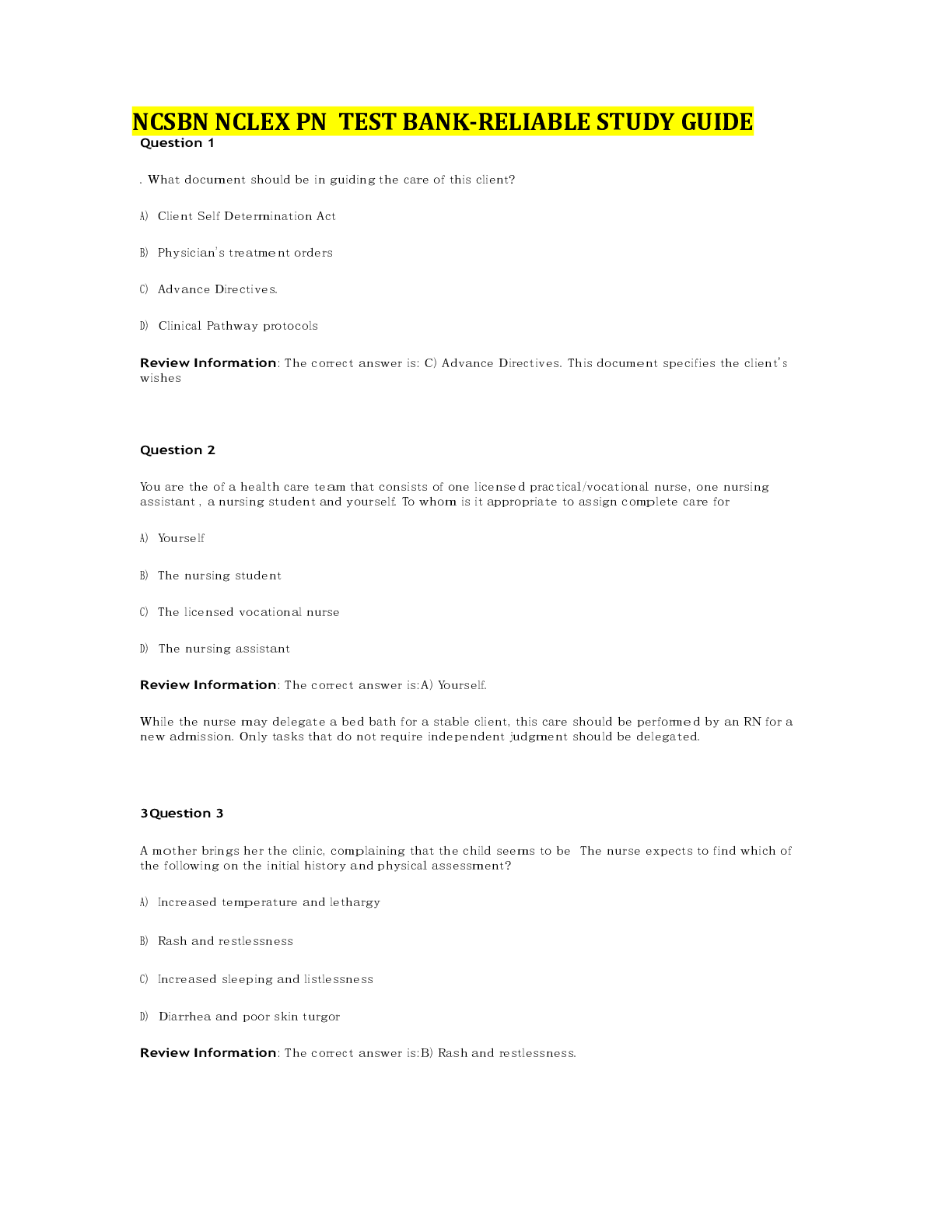
Reviews( 0 )
Document information
Connected school, study & course
About the document
Uploaded On
May 12, 2021
Number of pages
495
Written in
Additional information
This document has been written for:
Uploaded
May 12, 2021
Downloads
0
Views
61

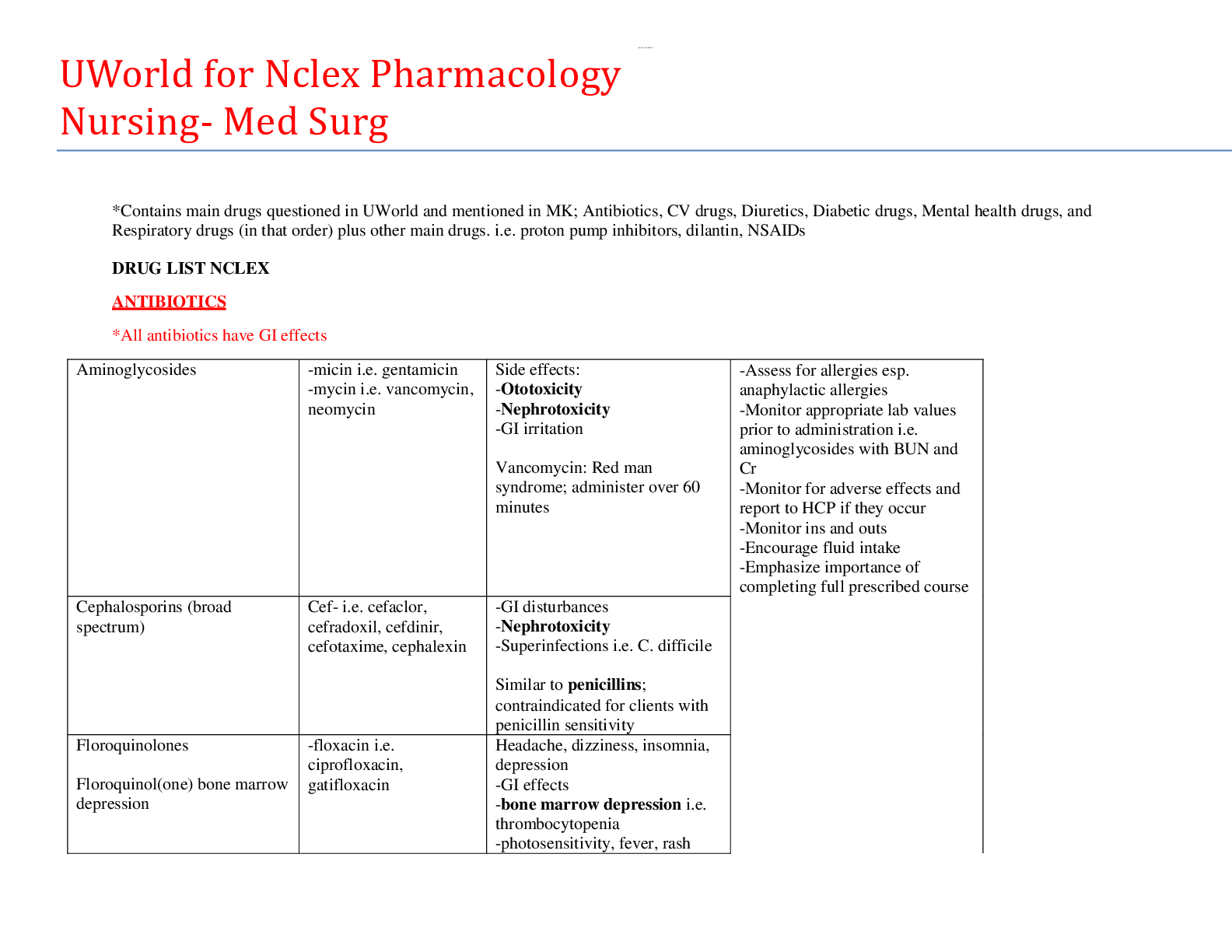

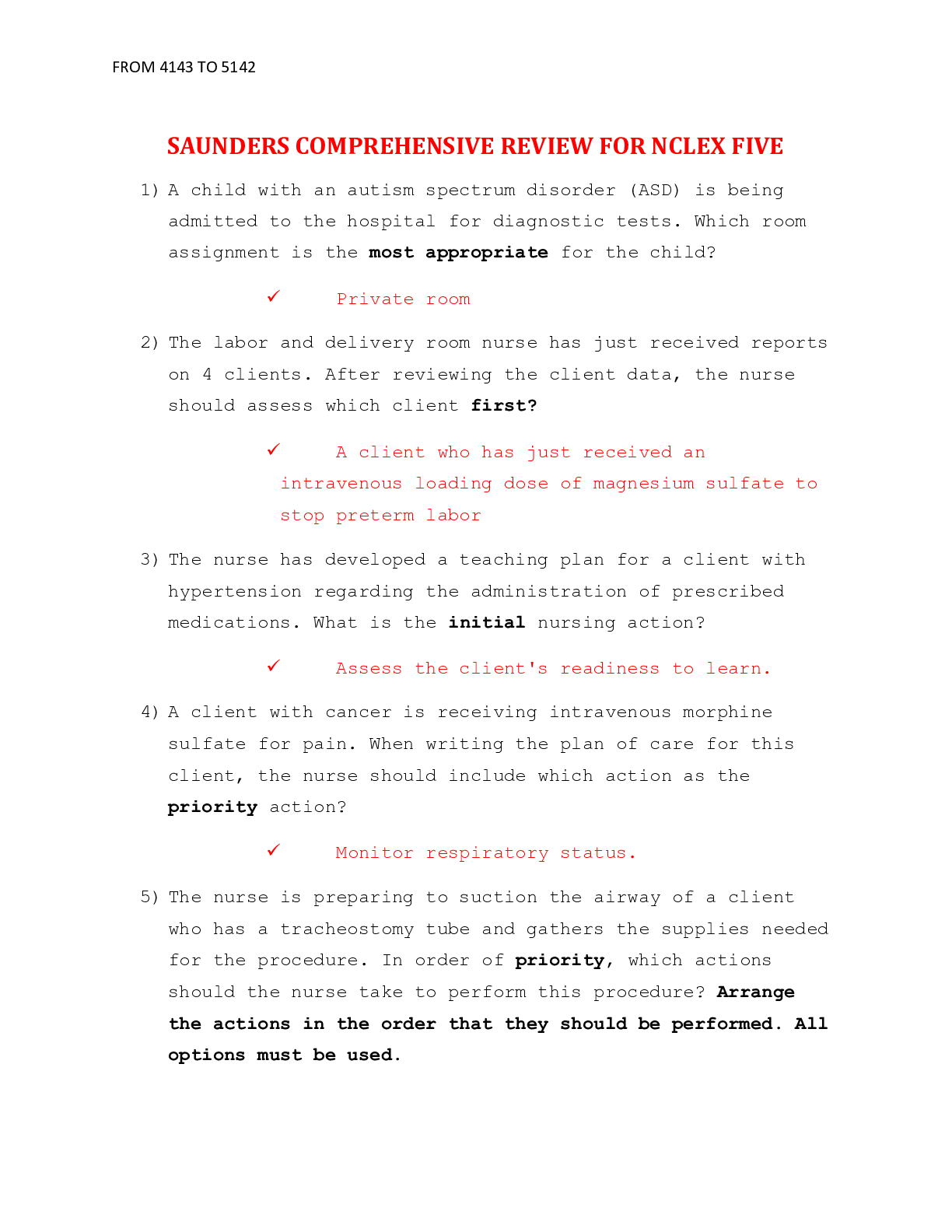
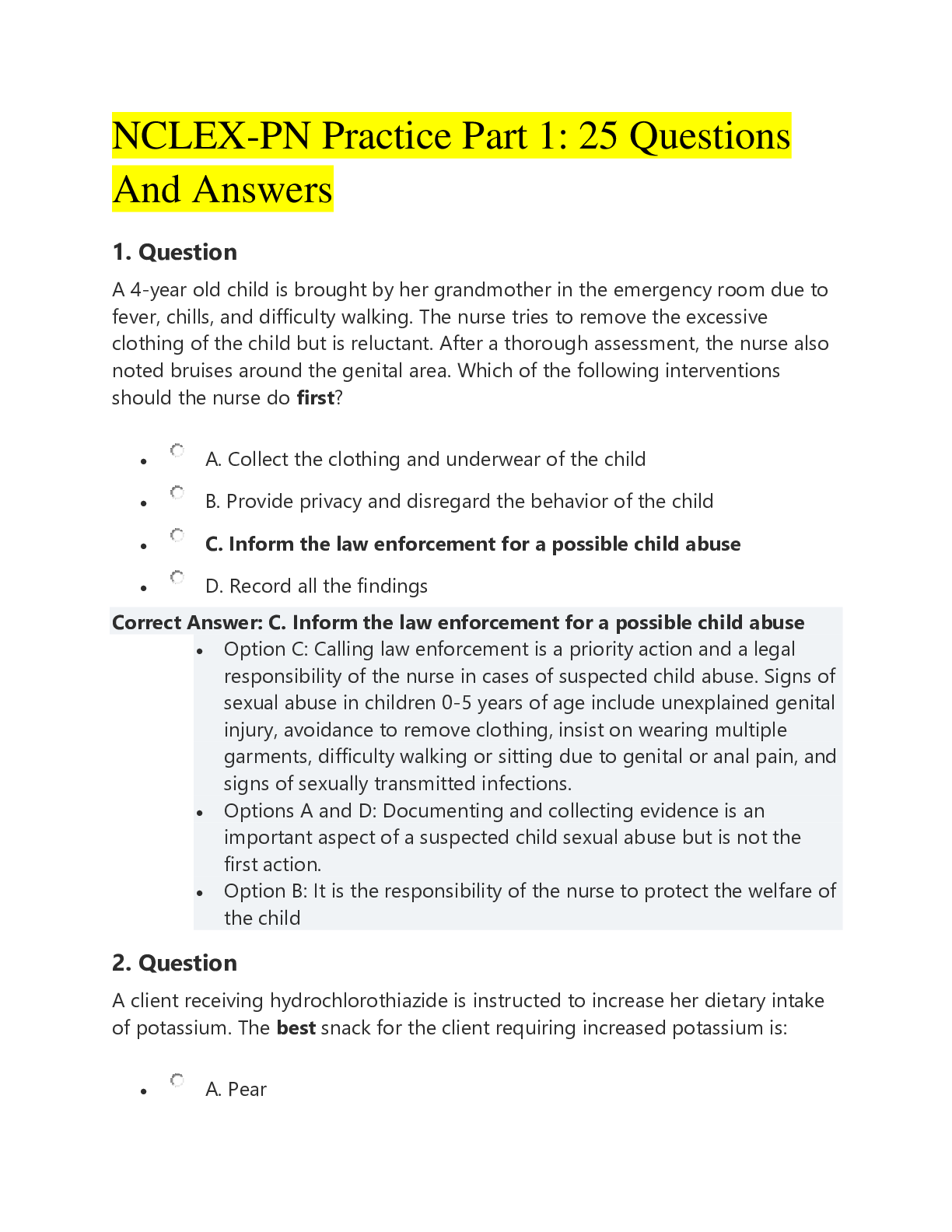
.png)
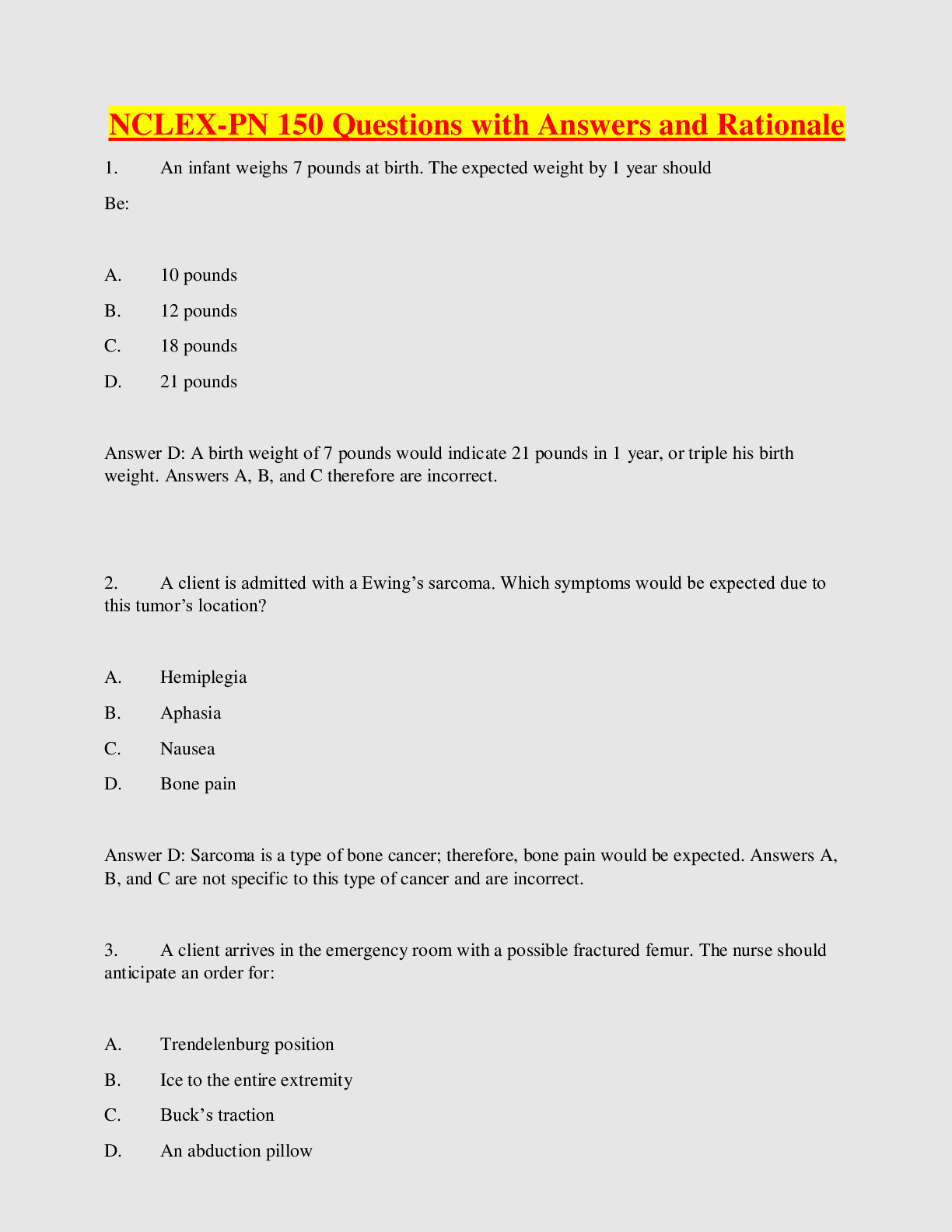


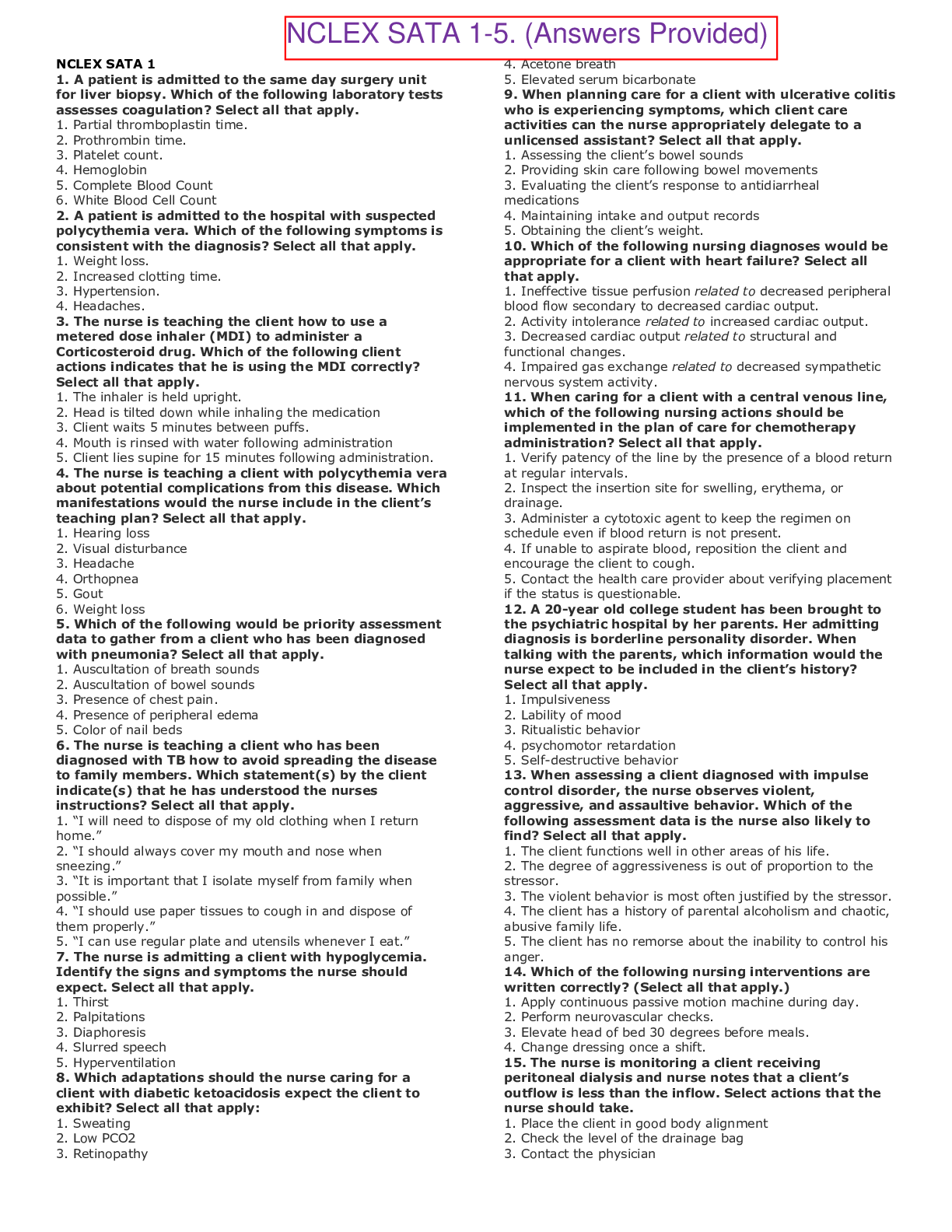


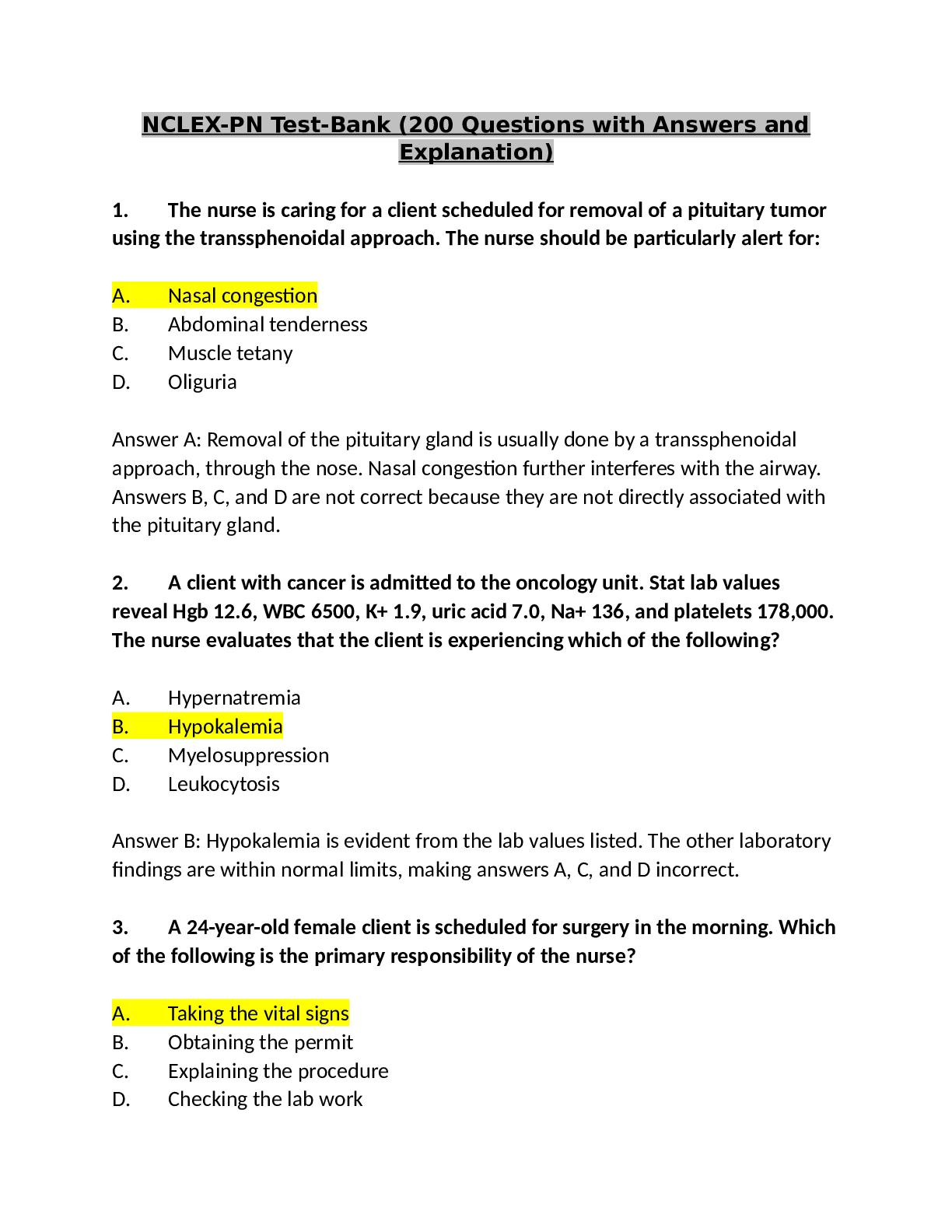

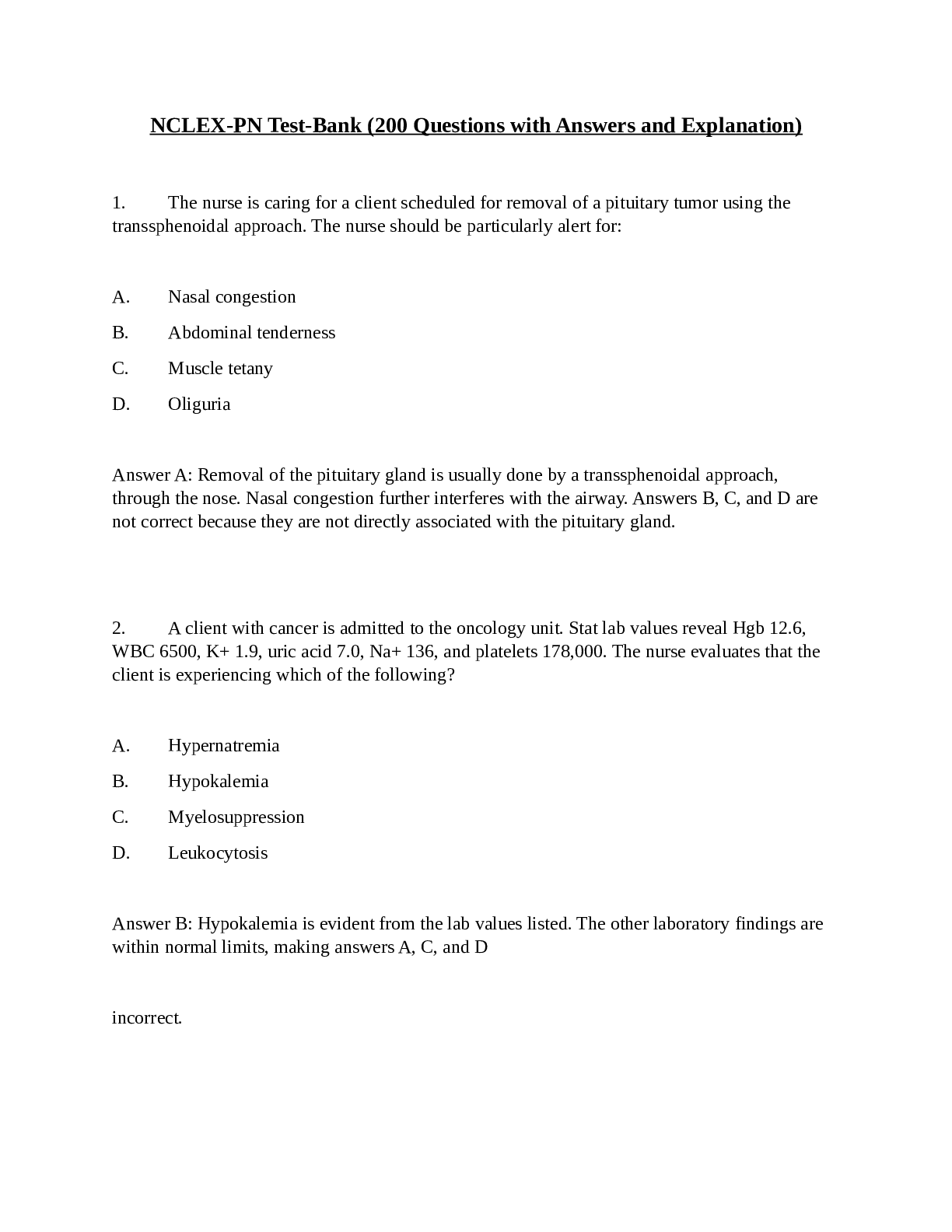
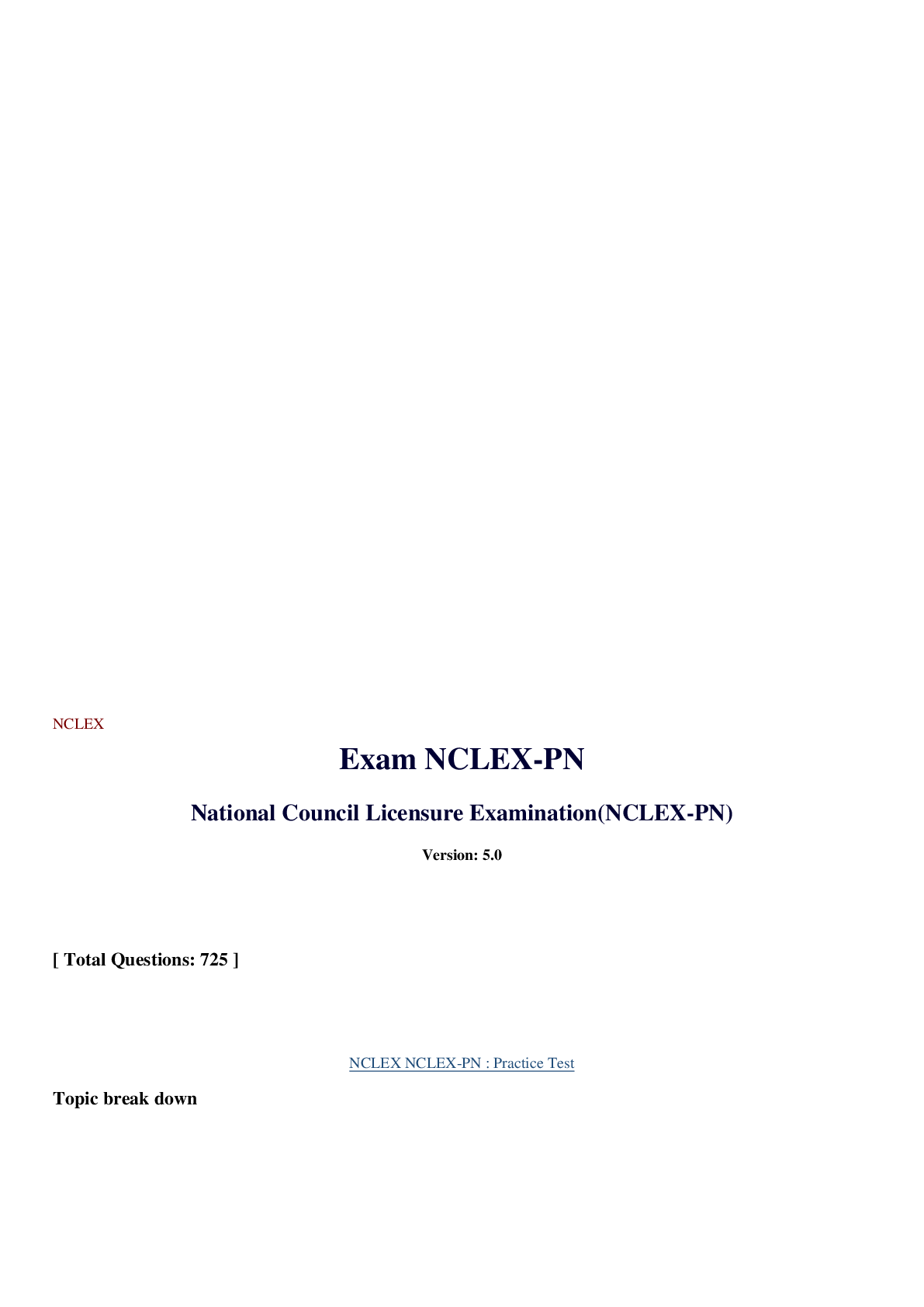
.png)
 Latest 2022-2023.png)

